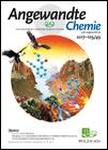版权所有:内蒙古大学图书馆 技术提供:维普资讯• 智图
内蒙古自治区呼和浩特市赛罕区大学西街235号 邮编: 010021

作者机构:Departments of Molecular Genetics Biochemistry & Chemistry University of Toronto Toronto Ontario M5S 1A8 (Canada) NMR Science Campbell CA 95008 (USA) Hospital for Sick Children Program in Molecular Structure and Function 555 University Avenue Toronto Ontario M5G1X8 (Canada)
出 版 物:《Angewandte Chemie》 (应用化学)
年 卷 期:2015年第127卷第36期
页 面:10653-10657页
学科分类:081704[工学-应用化学] 08[工学] 0817[工学-化学工程与技术]
主 题:CEST Konformationsdynamik Nicht‐uniformes Sampling Proteine Pseudo‐4D‐NMR
摘 要:Chemical exchange saturation transfer (CEST) NMR spectroscopy is a powerful tool for studies of slow timescale protein dynamics. Typical experiments are based on recording a large number of 2D data sets and quantifying peak intensities in each of the resulting planes. A weakness of the method is that peaks must be resolved in 2D spectra, limiting applications to relatively small proteins. Resolution is significantly improved in 3D spectra but recording uniformly sampled data is time‐prohibitive. Here we describe non‐uniformly sampled HNCO‐based pseudo‐4D CEST that provides excellent resolution in reasonable measurement times. Data analysis is done through fitting in the time domain, without the need of reconstructing the frequency dimensions, exploiting previously measured accurate peak positions in reference spectra. The methodology is demonstrated on several protein systems, including a nascent form of superoxide dismutase that is implicated in neurodegenerative disease.